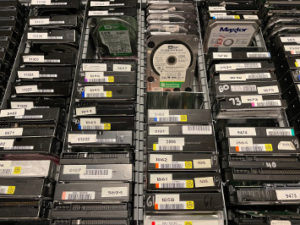 From a consumer storage standpoint, hard disk drives (HDDs) aren’t as popular as they used to be. Solid-state drives (SSD) are significantly faster and more capable of performing in a variety of conditions — which is why Microsoft is pushing manufacturers to use SSDs as primary storage devices.
From a consumer storage standpoint, hard disk drives (HDDs) aren’t as popular as they used to be. Solid-state drives (SSD) are significantly faster and more capable of performing in a variety of conditions — which is why Microsoft is pushing manufacturers to use SSDs as primary storage devices.
But while HDDs may not be standard hardware in the next generation of laptop and desktop computers, the technology won’t disappear anytime soon. A recent report from the International Data Corporation (IDC) indicates that hard drives will become even more essential over the next several years, thanks to a rapid rise in demand for low-cost data storage.
Generative AI creates (and requires) tremendous amounts of data.
Artificial intelligence (AI) isn’t just a buzzword — after all, buzzwords don’t create a massive draw on real-world resources, and that’s exactly what we’re seeing in storage markets.
The IDC estimates that the average annual growth rate of data storage capacity demand for generative AI learning data is as high as 20%. In the Asia/Pacific region, spending is anticipated to skyrocket to $26 billion by 2027, exhibiting a substantial compound annual growth rate (CAGR) of 95.4% over the 2022-2027 period.
So, why is that good news for hard drive manufacturers? Every bit of data created by AI tools will need to be stored in the long-term, and hard drives are simply the best tool available for the job.
- Hard drives are much less expensive than solid-state storage, with an average total cost of about $0.14 per gigabyte. Even by conservative estimates, SSDs cost at least $.30 per gigabyte.
- Solid-state storage has a limited number of write/rewrite cycles. This isn’t a significant issue for consumer computer systems, but in enterprise storage, it’s a major limitation; hard drives are often a more reliable option.
- While data tape systems provide a lower cost per gigabyte and better durability, hard drives provide faster access to data, which is essential for AI and other high-performance applications.
Related: 4 Things to Know About SSD Write Cycles
New storage technologies will power the growth of AI.
To meet the growing demand, however, HDD manufacturers cannot simply rest on their laurels. New technologies must be introduced to make hard drive storage as reliable and efficient as possible. That will mean more widespread usage of Heat-Assisted Magnetic Recording (HAMR) and Shingled Magnetic Recording (SMR), two technologies that extend the areal capacity of HDDs.
This year, major manufacturers have introduced hard drives with 32 terabyte capacities, and larger drives may be on their way to data centers in the near future.
Most HDD manufacturers also produce solid-state storage, and companies are simultaneously looking for ways to drive down the cost of SSD storage. Given the enormous per-gigabyte price difference between magnetic and electronic data storage technologies, SSDs will likely remain the more expensive option for the foreseeable future.
And while SSDs are less expensive to operate — a key point of concern for data centers — they’re also more subject to fluctuations in production efficiencies. HDDs don’t require etching, and even with HAMR/SMR drives, they’re simply a less complex technology than solid-state storage.
Data Recovery Resources for HDDs, SSDs, and Enterprise Systems
Datarecovery.com provides solutions for all storage technologies, including next-generation technologies like HAMR and SMR. From consumer media to datacenter storage arrays, we’re equipped to restore data to a usable state while minimizing turnaround time and cost.
All of our services are supported with a no data, no charge guarantee: If we’re unable to recover the files you need, there’s no charge for the attempt. To learn more, call 1-800-237-4200 to speak with an expert or submit a case online.




